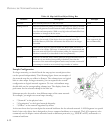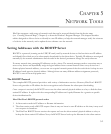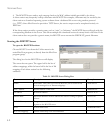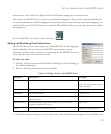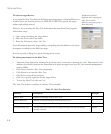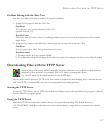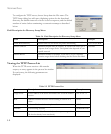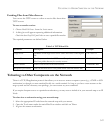
D
EFAULT
I
NFORMATION
5-5
Default Information
EliteView’s BOOTP Server provides flexible filename mapping. However, you may find it most convenient to
establish a common default for most nodes on the network.
To define a default address with IP and physical addresses:
1. Select the “default” address (0.0.0.0).
2. Define file mappings applicable to all nodes on the network.
Every BOOTP request to lookup a filename will be checked in this priority:
1. Consult the specific node address.
2. If no address is found for the specified node, consult the default file mappings.
In addition to the explicit default file mappings, the BOOTP Server also provides implicit default file mapping.
When a node is included in the address list and the client station provides no generic filename, it is asking for a
default file mapping that you must provide. A DEFAULT filename must be defined for all stations requiring this
type of mapping. If a DEFAULT generic name is not defined, the request is ignored.
Probing Devices with the Alive Test
The Alive Test serves as a basic network monitor. It determines link status by sending packets between
the network management station (i.e., your PC) and the target node (e.g., gateway, hub or node). This
test can be initiated from the Tools menu in the main EliteView program, from the Discovery module,
or directly from the EliteView program group.
The Alive Test can be used with any IP or IPX device – including devices that do not support SNMP (like
gateways). It cannot be used with the Ethernet protocol. To discover the existence of a device, the Alive Test uses
“ICMP echo” for UDP/IP networks, and the IPX Diagnostic command for IPX nodes. If a device responds
correctly, it returns the message to the sender. When the echoed message is received by the sender, it can
determine:
• Existence of the target device
• Round trip delay time
• Relative network throughput (transmission speed, etc.)
• Return ratio (percentage of packets correctly returned)




